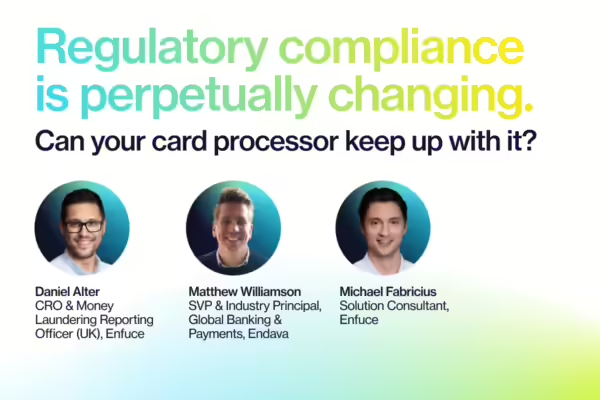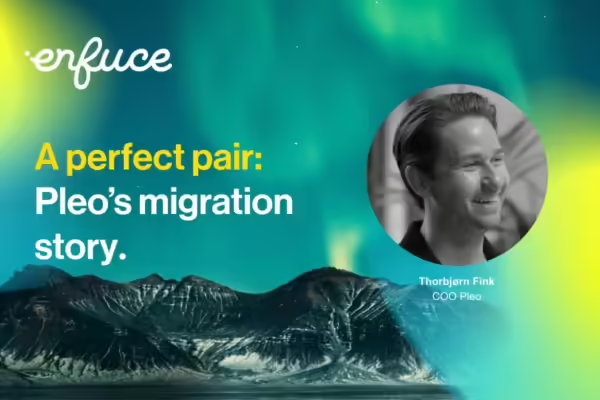Defining decisions: The build or buy debate webinar

If you’ve been following our Builders’ guide work, you’ll know we’re on a mission to demystify the debate around whether to build or to buy a card program – or to choose a hybrid version of both. By interviewing a collection of the world’s smartest card program creators, we’ve uncovered a wealth of insights on subjects like relationship-building, non-negotiable fundamentals and even learnings from failure.
Since we’re always hungry for refreshing thoughts, we’ve taken our report a step further by gathering some of the architects together for an even richer conversation.
Our webinar explored the build or buy topic in a lively debate, facilitated by Masha Cilliers (Founder & Principal Consultant, Payment Options Ltd) and featuring Victor Kotnik (Partner Consulting, Deloitte) and Thorbjorn Fink (COO, Pleo), but this time joined by Enfuce’s own Philip Mikal (CPTO) and Sharon Robson (VP, Product Marketing).
In this article, you will learn more about:
- How to decide what to build and what to buy
- Learning from your partners
- Big challenges of big banks
Download the Builders guide to strangely satisfying card experience here to get the full picture of our findings.
Starting strong
It’s a subject that’s always been a challenge in payments, especially when deciding which part of a portfolio could be built and what could be outsourced. The way our builders panel have approached it is by analysing the fundamentals required for each approach as a solid starting block.
The key thing to keep in mind, as Fink reminds us, is that no one size fits all.
“What we at Pleo have come to realise over the past 9 years is that it’s an impossible task for any organisation to do everything themselves.”
Thorbjørn Fink – COO at Pleo
For scale-up Pleo, a crucial decision to make was around the kind of customer experience the brand wanted to provide and which partners could help them achieve it. This in itself was a balancing act, as it was important for the business to own some of the stack that governed the experience to ensure Pleo retained control over it. Other services however, like payment processing which requires experience and skill was something Fink was happy to outsource. Speed to market was another key point for Pleo, given their rapid growth as a start-up, which also affected their decision. When scaling up and with the need to move fast, buying a solution outright has its advantages which also allows for reflection. If the solution has been a good market fit, could there be future opportunity to own a greater share of the experience?
While banks and larger financial institutions face a similar choice, Victor Kotnik believes the considerations of what to build and what to buy are fairly clear. Many of the services – like cards and payments – that require large numbers of skilled resources and significant management capacity are widely available to purchase or to partner with. These services are pretty standard and Kotnik feels that banks would rather focus on differentiation at the point of customer engagement.
Start-ups, scale-ups and failing forward
Philip Mikal believes a challenging consideration for many organisations is to acknowledge whether they have either the core competency to build or if they even have to (or need to) in order to have a competitive advantage.
For Fink, the competency to build Pleo’s own card program was evident, but the brand chose to buy (partner) with Enfuce instead.
“From a start-up/scale-up perspective, we learn a lot from our partners along the way. This whole area is extremely complex and there’s just so much to think about. When you’re starting a business from the ground-up, you have your eye on the end customer and their experience which goes above and beyond our payments infrastructure. Often fintechs don’t really know what they need to own and are trying to focus on many other things, meaning they can’t also be the payments specialist – they need partners to guide and educate them.”
Sometimes however, as Mikal points out, fintechs don’t know what they don’t know.
“I know from my own experience in start-ups, sometimes you have a certain arrogance that you’ll be able to simply figure it out and it’s sometimes not until you find the right partner that you get that advice. So, you need a certain level of awareness to select the right vendor when buying to teach you and to provide the right resources for your business.”
From Masha Cilliers’ experience on the acquiring side, many businesses start out with that kind of arrogance only to quickly realise the enormity of the challenge. There are providers who will just give you the tools and those who guide organisations through the process all the way. This is particularly important when doing international business because the expertise required in areas like customer protection laws is so significant.
Big banks, big challenges
Banks and larger financial organisations may have the initial knee-jerk reaction to want to build and not to buy or partner, wanting to own the full capability and in doing so, provide a point of differentiation from their competitors.
But as Sharon Robson comments, between the two options of build or buy, there are a myriad of considerations, challenges and opportunities for big players to weigh up – especially when deciding on a timeline of transformation.
“We work with different size customers and some of the areas where it’s more complex are the larger established enterprises, the incumbent banks, where they have much more complex legacy infrastructure. And I think where we see the challenge is going from the phase of building on top of that and having digital interaction with customers and improving that customer experience, to deciding when the shift starts to take place in terms of really rebuilding complex legacy infrastructure. How do they move from where they are now into the cloud native, forward-looking approach to building solutions. That’s what this debate is really about.”
“I think we are starting to see a shift now where some of these big banks are starting to look more seriously at evaluating their infrastructure back-end applications and asking, ‘is this fit for the future? Do we need to change it, how do we go about it?’”
Victor Kotnik- Partner Consulting, Deloitte
For Victor Kotnik, who works with many of the biggest banks in the Nordics, change (and appetite for it) has been ongoing and visible for many years.
“For the banks I work with, the focus for many years now has been to improve in their customer relationships, their front end, their systems of differentiation and that type of thing, but they have also invested heavily in decoupling some of their architectures. I think we are starting to see a shift now where some of these big banks are starting to look more seriously at evaluating their infrastructure back-end applications and asking, ‘is this fit for the future? Do we need to change it, how do we go about it?’ In the past 2 years, two of the big seven banks have started that journey.”
The build or buy debate is a debate for a reason – there are so many considerations to evaluate and an enormous depth of complexity to navigate. But what’s clear is that the need for change, for agility and seamless operational efficiency is a very real one and whichever route a business decides to go, it promises to be an eventful one.
Interested in learning more? Read our Essential Guide to the Build or Buy Conundrum today!



